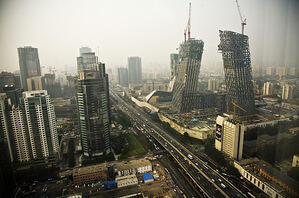One clear difference between TiF and these earlier projects is the economic situation. PIPE and IC were lucky. They operated during a period of economic growth and optimism. In contrast, economic constraints are likely to be the background music to the work of TiF. Hopefully, the new project can generate its own excitement and sense of purpose and achievement. It should inspire the participants, during what is likely to be a tough time in their mainstream work. TiF should build in activities that consciously try to give a boost to morale. The social side of transnational co-operation projects is important in building confidence and mutual support amongst partners. In these difficult economic times this should not be overlooked.
More fundamentally, some of the underlying thinking on which the project was designed may now need to be questioned. Let us look critically at some of these building blocks. First, the TiF project proposes to develop and apply an “Attractivity Barometer”. This sounds a nice idea, and implies that we will have a tool to measure and compare the partners’ towns or regions. Presumably the Barometer will be able to register changes in “attractivity” linked to improvements made by various partners. However, behind the idea of “attractivity” stands a model of growing markets and investor confidence: get the “attractivity formula” right and private sector investment will follow. While a country like Latvia, for example, was enjoying a huge property boom, this approach was credible. However, that bubble has burst, Latvian houses are now worth less than half what they were a year ago and there is talk of default on loans and of massive tax rises. How will the Barometer take account of this fundamental change in the economic climate? More fundamentally, as banks and investors seek security rather than risk, where is new development in marginal locations going to come from?
TiF foresees Regional Scenario Planning as a way to encourage growth, narrow inequalities and produce face-lifting plans. The recession makes all of this more difficult, though it does not invalidate the idea of doing Regional Scenario Planning. The scale of the economic shock, since the ideas behind TiF were first worked up in 2008, makes the value of scenarios and TiF’s promise of “new narratives and story telling” even greater. The issue now is not so much how to “attract growth”, as how to deliver development and investment in a cold economic climate. If TiF can create really new and compelling narratives around local co-operation, public leadership, national and European solidarity and the use of Structural Funds beyond 2013 then it could make a dramatic contribution that would resonate far beyond the partners themselves. Is the way forward some regional version of de-regulation and free-market fundamentalism, essentially the formula that produced the crash in the first place? Or are there alternative pathways that look to governments to operate in a more interventionist but smarter way? Can they combine strategic vision, with local mobilisation and realistic ambitions to create the conditions for a better future for small towns and rural regions outside the EU’s economic heartland?
TiF promises to work on “joint marketing packages”. This presumes that the basic problem is inadequate presentation of information. The more fundamental problem is the plunge in consumer spending. However, even in a recession there are some consumers with surplus income to spend. Thus this is not an argument against doing the “joint marketing packages”, but TiF should be realistic about what they might deliver. I would suggest that the joint marketing needs in part to be directed at local residents, building their confidence in the places where they live, and mobilising their commitment to the cause of making tangible but affordable improvements. Examples might be through energy saving initiatives, or through local support groups or credit unions.
These difficult external conditions make the part of TiF that is concerned with the design of “an interactive public space” especially important to what the project can deliver. An idealised, attractive but expensive and infeasible design will risk being left on the shelf and not implemented. However, a low-key and cheap project may lack the scale and quality to make any discernable difference. Very careful thought needs to be given to identifying sites and projects so as to maximise the potential benefits in relation to the wider goals of TiF. The challenge then to deliver a high quality output is one that will require not just design skills but financial commitment and good project management.
None of these comments should be read as a criticism of the TiF project. Quite the reverse. I believe that if TiF factors in the economic realities from the start, it has a much better chance of succeeding than if it operates on a mental model fashioned before the currently economic crisis kicked off. Furthermore, if it can imagine and then demonstrate practical ways forward in today’s tough conditions, it will be an outstanding project. The starting point along that route has to be a recognition that a local or regional authority must be innovative, provide leadership, set agendas and merit the loyalty and respect of its local stakeholders. TiF needs to be a catalyst to really trans(in)form its partners.

